Anemone Fish and Anemones – Mutualism at its Best
|March 7, 2024

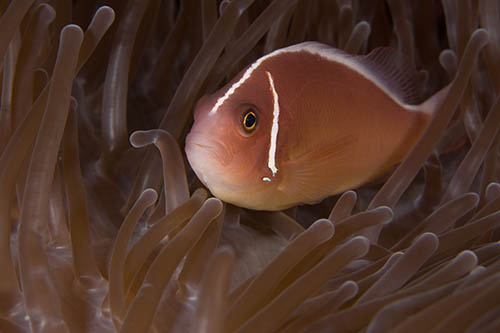
Thanks to Disney Pixarâs 2003 blockbuster âFinding Nemoâ, anemonefish are among the most popular fish in the world, however these beautiful fish and their symbiotic relationships with their host anemones have been a favourite among divers and snorkellers since we first started exploring the underwater world.
Bunaken Marine Park is home to numerous species of anemonefish, and our house reef âSiladen Jettyâ is one of the best places to see them. We have more than eight species on our house reef alone, and because their host anemones tend to favour the shallower waters, both divers and snorkellers have an equal opportunity to encounter them.
What is a Sea Anemone?
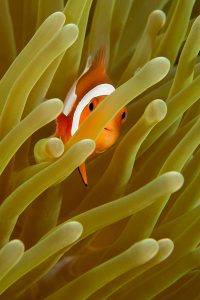 Â Named after the colourful flower âAnemoneâ because of their bright colours, sea anemones are actually a predatory animal that are found in the phylum Cnidarian, which means they are related to corals, jellyfish, and hydroids.
 Named after the colourful flower âAnemoneâ because of their bright colours, sea anemones are actually a predatory animal that are found in the phylum Cnidarian, which means they are related to corals, jellyfish, and hydroids.
 Most anemones attach themselves to the substrate via their pedal disk (base), have a columnar trunk with an oral disc (mouth) and this is surrounded by a ring of tentacles. These tentacles are coved in stinging cells, which are used to trap food and direct it to its oral disc.
 Like corals, many anemones form symbiotic relationships with either zooxanthellae, or zoochlorellae, which gives the anemone extra nutrition and energy, and exactly like corals, anemones can bleach when the water gets too warm for a prolonged period of time.
Â
How do Anemonefish live in Anemones?
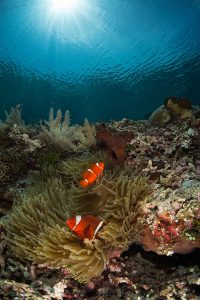
 Because the tentacles are covered in stinging cells, most fish will avoid them, however anemonefish have evolved a genius way to bypass the sting.
Some species of anemonefish are born with a protective mucus like layer that allows them to slip through the stinging tentacles without any issues. Other species must adapt to their host anemones stinging cells by slowly easing their way into them. At first the anemonefish will receive mild stings, however over time they will build up an immunity and develop their own mucus coating.
To avoid having to endure this experience, the anemone fish will adjust their own body chemistry so it matches that of the host anemone, and once this has happened the anemone will no longer recognise the fish as potential food, and allow it to pass through freely without being stung.
 The Perfect Example of Mutualism
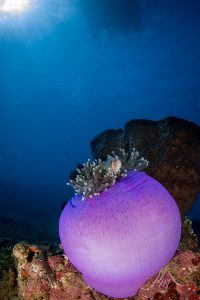
 The relationship between anemonefish and anemones is known as mutualism â a form of symbiosis where all parties involved benefit from the relationship.
Once the anemonefish has adapted to the venomous stinging tentacles, they have something that most other fish will never have â a safe home where predators cannot get to them. In exchange, the fish will help circulate fresh water throughout the tentacles. The toilet waste from the anemonefish will also be eaten by the host anemone, so they provide a second food source for them.
Some species of anemonefish are notoriously aggressive, often chasing away fish (and even divers) who are many times larger than them. Although the anemone has stinging cells to help protect them, they are not powerful enough to take on larger polyp eating predators such as butterfly fish, however these anemone eating fish are no match for the aggressive anemonefish that will defend its home at all costs.
There have been studies throughout the world regarding anemone fish and anemones, and the majority have concluded that when anemone has at least one anemonefish living inside it, both animals have a far higher survival rate compared to when âgoing aloneâ. Not only that, but anemones have been shown to grow up to three times faster, and they reproduce more â both sexually and asexually.
The deep walls throughout Bunaken Marine Park showcase multiple examples of mutualistic relationships, however the relationship between anemone fish and anemones is probably the easiest to see, and one of the most effective.
 Photographing Anemone Fish
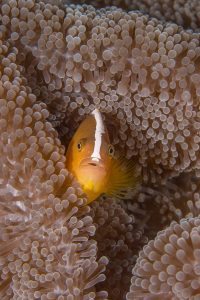 Because of their bright colours, lack of fear, and prevalence throughout the area, anemonefish and their host anemones are among the most commonly photographer subjects in Bunaken Marine Park.
Because of their bright colours, lack of fear, and prevalence throughout the area, anemonefish and their host anemones are among the most commonly photographer subjects in Bunaken Marine Park.
Because they are so territorial, they will often âface offâ to the camera, which gives photographers the perfect opportunity to get a head on shot with the fish actually looking at the camera. Even the shier species will not back away when the anemone is approached.
Anemones and anemone fish are very common subjects for close focus wide angle photography. Because the anemones are very colourful, they make a wonderful foreground subject, and as they cannot move, you can wait for an interesting background subject to appear, such as a turtle or a school of wide mouth mackerel.
Many anemones also tend to prefer areas of higher current, so they are easy to find on either the top of the reef, or on a corner. This allows a wide angle photographer to include a lot of open water, and possibly the sun, in the image, which usually ends with fantastic results as the striking colours of the anemone really stick out.
For those who prefer to go macro, you have equally as fantastic opportunities to photograph anemone fish. They tend to move around quite a bit, so unless you are very patient, we would not recommend having too powerful a macro lens, as it may be very difficult to frame the subject. One thing to look out for with macro photography is the parasite, Cymothoa exigua, a tongue eating louse that belongs more in a science fiction movie than real life, is relatively common in anemonefish.
The post Anemone Fish and Anemones – Mutualism at its Best appeared first on Siladen Resort & Spa Indonesia.